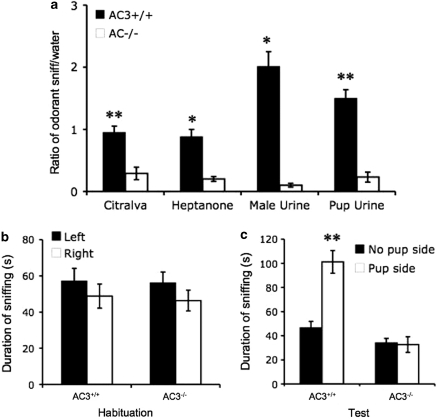Figure 4.
Virgin AC3−/− female mice fail to detect odorants and pup urine. (a) Odorant habituation data for AC3+/+ and AC3−/− virgin female mice are reported. Cotton swabs were laced with 50 μl of citralva (10 μM), 2-heptanone (50 μM), male urine (20-fold diluted), or pup urine (20-fold diluted). There were significant differences in the ability of AC3+/+ (n=10) and AC3−/− (n=10) mice to detect citralva (p<0.001), 2-heptanone (p<0.01), male urine (p<0.01), and pup urine (p<0.001). Data are represented as means±SEM. (b and c) Virgin female AC3+/+ mice but not virgin AC3−/− females detected anesthesized pups. Non-visual pup detection was assayed as described in Materials and Methods using anesthesized pups. (b) During context habituation, AC3+/+ (n=8) and AC3−/− (n=8) female mice sniffed each side chamber equally. However, during testing (c) AC3+/+ female mice, but not AC3−/− females, showed a strong preference for the side chamber containing the anesthesized pup (p<0.001). Data are presented as means±SEM. *p<0.01; **p<0.001.

